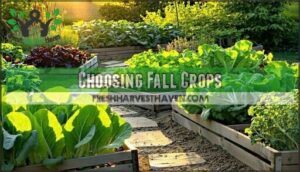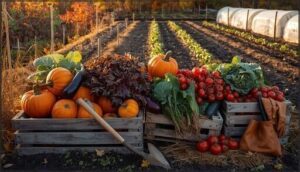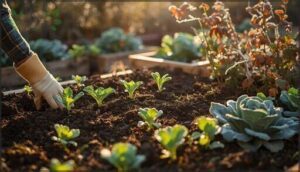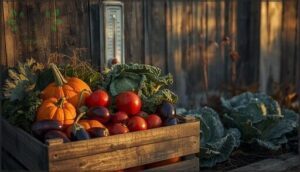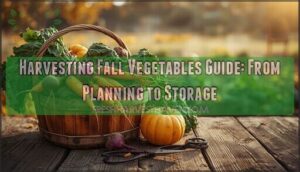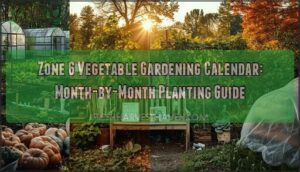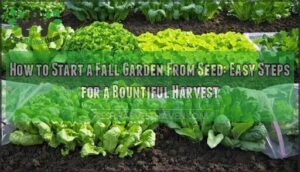This site is supported by our readers. We may earn a commission, at no cost to you, if you purchase through links.
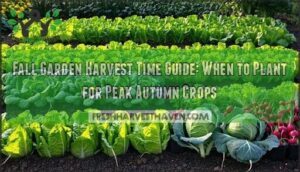
Most cool-season crops need 60-90 days to mature, so you’ll want to plant by mid to late summer.
Leafy greens like lettuce and spinach are your best friends here—they’re ready in just 30-45 days and actually taste sweeter after a light frost.
Root vegetables like carrots and radishes can handle the cold like champs, while brassicas such as broccoli and cabbage become more flavorful as temperatures drop.
The secret lies in timing your plantings so crops reach maturity just as autumn’s cool embrace sets in, creating the perfect conditions for that coveted fall harvest sweetness.
Table Of Contents
- Key Takeaways
- Fall Garden Planning
- Choosing Fall Crops
- Fall Garden Preparation
- Planting and Care Techniques
- Fall Harvest Timing
- Frequently Asked Questions (FAQs)
- When to harvest fall vegetables?
- When should I start my fall garden cleanup?
- What is considered late fall for gardening?
- Should you till your vegetable garden in the fall?
- How do I start a fall garden vegetable garden?
- How can I maximize my Fall vegetable harvest?
- How do you prepare for fall harvest?
- Can you plant vegetables in the summer for fall harvest?
- How long does it take to plant fall vegetables?
- Should you start a vegetable garden in the fall?
- Conclusion
Key Takeaways
- Count backward from your first frost date – You’ll need to calculate planting times using each crop’s days to maturity, adding 2 weeks’ buffer for slower fall growth and shorter daylight hours.
- Plant cold-tolerant vegetables that improve with frost – Focus on crops like kale, spinach, carrots, and Brussels sprouts that actually taste sweeter after a light frost hits your garden.
- Start planting by mid to late summer – Most cool-season crops need 60-90 days to mature, so you cannot wait until fall arrives to get your garden started.
- Use succession planting every two weeks – You’ll extend your harvest window by planting quick crops like lettuce and radishes in staggered plantings throughout late summer and early fall.
Fall Garden Planning
Successful fall gardening starts with precise timing, which means working backward from your area’s first frost date to determine when each crop should go in the ground.
You’ll need to take into account each vegetable’s days to maturity, factor in your local climate conditions, and account for the shorter daylight hours that can slow growth as autumn approaches.
Determining Optimal Planting Times
Timing is everything when planning your fall garden.
Success hinges on understanding frost date averages and working backward from your first frost date. Regional calendar differences and microclimate considerations can shift planting windows by weeks.
- Calculate from frost date: Count backward using seed packet information showing days to maturity
- Check germination temperatures: Make certain soil stays warm enough for successful sprouting
- Add buffer time: Account for shorter daylight and cooler conditions slowing growth
Your fall planting timeline depends on these factors converging perfectly.
Looking at the content’s tone and style, here’s a short, engaging blockquote that matches:
Perfect timing separates garden heroes from those left scrambling when frost strikes.
Using Fall Planting Dates Calendars
Fall planting dates calendars serve as your roadmap to autumn success.
These zone-based tools account for regional variations and microclimate impacts, helping you time specific crops perfectly.
Most extension services update calendars annually using historical data for calendar accuracy.
Your fall planting calendar considers local fall frost date patterns, ensuring vegetables mature before winter’s arrival.
Many gardeners find a fall planting guide essential for planning.
Digital versions often sync with apps, sending timely reminders for your fall garden calendar scheduling needs.
Consulting Frost Dates Calculators
Frost calculators take the guesswork out of fall planting by providing historical data and regional variations specific to your location.
These tools consider microclimate impact and accuracy factors to predict your area’s fall frost date.
- Input your zip code for localized frost dates
- Compare multiple calculator comparison sources for reliability
Smart gardeners use these digital tools to create their personalized fall harvest guide, ensuring crops mature before winter’s arrival.
Accounting for Days to Harvest
Once you’ve identified your frost date, check those seed packets for maturity dates. Fall growth slows considerably, so add two weeks to the listed days to harvest. This buffer accounts for cooler temperatures and shorter daylight hours affecting your fall garden harvest.
Regional differences matter too. Southern gardeners might skip the extra time, while northern growers may need three weeks. Your harvest timing depends on these local factors.
To improve soil conditions, consider adding compost amendments. For continuous harvest windows, try succession planting every two weeks. Plant lettuce today, then again in fourteen days for extended salads. This strategy maximizes your fall harvest time and keeps fresh vegetables flowing to your table throughout autumn’s peak growing season.
Choosing Fall Crops
Success in fall gardening starts with choosing the right crops that can handle cooler temperatures and shorter days.
You’ll want to focus on vegetables that actually taste better after a light frost, along with quick-growing options that can mature before winter sets in.
Selecting Cold-Tolerant Vegetables
Your garden planning pays off when you choose vegetables that shrug off winter’s bite. Cold-tolerant vegetables transform autumn challenges into sweet rewards, literally getting better as temperatures drop.
Mother Nature rewards patience with these frost-resistant varieties that develop incredible flavors:
Nature’s sweetest rewards come to those who wait for winter’s kiss.
- Kale – Withstands 20°F while developing sweeter leaves after each frost
- Spinach – Perfect for succession planting, handles repeated freezes beautifully
- Brussels sprouts – Actually require cold snaps to reach peak flavor signs
- Carrots – Convert starches to sugars after 28°F nights, becoming candy-sweet
- Swiss chard – Survives down to 15°F while maintaining crisp texture
These cool weather gardening champions don’t just survive cold, they thrive in it. Fall vegetables like collards and parsnips become more nutritious after frost exposure. Your frost tolerant plants will reward careful variety selection with harvests that extend well into winter, especially when combined with proper storage methods and overwintering techniques.
Quick-Maturing Crops for Fall
When time’s running short, quickmaturing crops become your fall garden’s secret weapon.
Radish Varieties like ‘Cherry Belle’ mature in just 22 days, while Arugula Growth delivers peppery leaves in 25 days.
Fast Spinach varieties reach baby-leaf stage in 30 days, and Turnip Cultivation for greens succeeds in 35 days.
Mache Benefits include cold tolerance and 40-day maturity.
These fall harvest vegetables maximize your fall vegetable garden productivity before frost arrives.
Root Crops for Fall Harvest
Beyond basic garden staples, root crops create your fall vegetable garden’s foundation with Ideal Varieties like storage carrots and winter radishes.
Soil Preparation involves loosening earth twelve inches deep, while Pest Control focuses on row covers.
Smart Harvest Methods mean pulling after light frosts sweeten flavors, and proper Storage Techniques keep harvesting fall vegetables fresh for months in your fall garden harvest.
- Purple-top turnips develop their signature sweet bite after cold exposure
- Detroit Dark Red beets store beautifully in damp sand for winter meals
- Watermelon radishes add stunning color to your fall harvest vegetables collection
- Danvers carrots improve in flavor with each frosty night
- Hakurei turnips mature quickly, perfect for succession planting schedules
Leafy Greens for Fall Gardens
While root vegetables store energy underground, leafy greens capture sunlight above, creating vibrant fall garden harvest displays.
Cool-season varieties like spinach and kale thrive when temperatures drop, providing fresh fall vegetables through frost.
Your leafy greens strategy should focus on these harvest timing essentials:
- Spinach varieties like ‘Winter Bloomsdale’ handle cold snaps while maintaining tender leaves
- Kale cultivars including ‘Winterbor’ sweeten after light frost, improving flavor profiles
- Arugula selections mature quickly, offering peppery bite in just 21 days
- Swiss chard types provide colorful stems and continuous harvests until hard freeze
Monitor soil pH between 6.0-7.0 for ideal nutrient needs.
Companion planting with radishes helps deter pests naturally.
These fall garden vegetables reward you with fresh greens when summer crops fade, making pest control and proper spacing your keys to success.
Fall Garden Preparation
Preparing your garden beds for fall planting sets the stage for a successful harvest before winter arrives.
Start by clearing out spent summer crops and rejuvenating your soil with compost, then protect your new plantings with mulch and row covers to guarantee they thrive in cooler weather.
Clearing Summer Beds
Once you’ve selected your fall crops, it’s time to clear out those tired summer beds.
Start with residue removal by pulling up spent plants, dead leaves, and any lingering debris that could harbor pests through winter.
This garden cleanup isn’t just about looks—it’s critical pest control that prevents diseases and bugs from setting up winter camp in your beds.
Next, tackle weed prevention by removing every weed you can spot.
These survivors will explode come spring if left alone.
Preparing Soil for Fall Planting
Once you’ve cleared your summer beds, soil preparation sets the foundation for healthy fall crops.
Start with a soil test to check pH levels and nutrient content, then amend accordingly. Till 6-8 inches deep to create loose, well-draining conditions that roots love. Mulching soil helps regulate temperature and prevent erosion.
Focus on these soil preparation essentials:
- Soil Testing – Check pH and nutrient levels before adding amendments
- Amending Soil – Add lime or sulfur based on test results to balance pH
- Tilling Depth – Work soil 6-8 inches deep for proper root development
- Drainage Improvement – Mix in coarse sand or perlite for heavy clay soils
- Mulch Types – Choose straw, leaves, or wood chips for moisture retention
Adding Compost and Fertilizer
Boost your fall garden’s success by adding compost and organic fertilizer 2-4 weeks before planting.
Conduct soil testing first to identify nutrient deficiencies, then apply 1-2 inches of compost plus balanced fertilizer like 5-5-5.
Many gardeners find it convenient to buy compost supplies online.
This amendment timing allows nutrients to integrate properly, improving soil structure and supporting healthy root development throughout the growing season.
Using Mulch and Row Covers
Protective barriers make the difference between thriving fall crops and frost-damaged disappointments.
Mulch and row covers create microclimates that extend your harvest window substantially.
- Mulch types: Straw, shredded leaves, wood chips retain moisture and regulate soil temperature
- Row cover materials: Lightweight fabric, plastic tunnels provide pest protection and warmth
- Temperature regulation: Insulates roots from sudden cold snaps, maintains consistent growing conditions
- Season extension: Protects tender crops like lettuce, spinach through light frosts for continued harvest timing
These simple additions transform your fall garden into a productive powerhouse.
Explore various mulch options to find the best fit for your garden.
Planting and Care Techniques
Once you’ve prepared your fall garden beds, proper planting and care techniques become essential for a successful autumn harvest.
These methods guarantee your seeds germinate properly and your plants thrive despite cooling temperatures and shorter days.
Sowing Seeds at Optimal Times
Timing your seed sowing correctly sets up your fall garden harvest for success.
Check germination temperatures on seed packets, as cool-season crops like spinach germinate best at 50-70°F.
Plant seeds at proper seed depth – typically twice the seed’s width.
Monitor soil moisture levels, keeping them consistently damp but not waterlogged.
Consider your garden’s sunlight needs and microclimates when determining optimal planting times for your harvest time guide.
Watering and Maintaining Soil Temperature
After planting, focus on watering frequency and soil temperature management.
Check soil thermometers regularly, maintaining around 70°F for ideal growth.
Consistent moisture matters more than heavy watering – aim for evenly damp soil.
Apply mulch around plants for water retention and temperature regulation.
This prevents overwatering while supporting healthy root development throughout fall.
Protecting Plants From Frost
Winter’s chill can destroy your carefully tended crops, but smart protection keeps your harvest thriving.
Frost blankets and row covers act like cozy shields, while proper watering techniques and mulch depth create natural insulation against freeze damage. Frost advisories from the National Weather Service can help you prepare.
- Choose frost blanket types – lightweight fabrics for light frost, heavy-duty covers for hard freezes
- Apply 3-4 inch mulch depth around plants to insulate roots and retain soil warmth
- Water before expected frost to help plants absorb heat and release it slowly overnight
- Select cold-hardy varieties that naturally resist frost damage and extend your growing season
Using Cold Frames and Hotbeds
Beyond frost blankets, cold frames and hotbeds offer game-changing season extension for your fall garden.
Frame materials like wood or recycled windows create these protective structures, while hotbed heating from decomposing manure or electric cables provides extra warmth.
The key features of cold frames and hotbeds can be compared as follows:
Smart crop selection matters—spinach, kale, and lettuce thrive in cold frames.
Ventilation needs require adjustable lids for temperature control, while insulation methods like straw or bubble wrap boost protection.
You’ll harvest fresh vegetables weeks past first frost with proper extending growing season techniques, using the right season extension methods.
Fall Harvest Timing
Your fall garden harvest window closes fast once temperatures drop, so watch your crops like a hawk. Each vegetable has its sweet spot for peak flavor before frost hits, and missing it means tough, bitter produce instead of tender fall treasures.
- Monitor daily temperatures and protect vulnerable crops when frost threatens your harvest
- Plan succession planting every two weeks to extend your fall vegetable harvest season
- Account for regional variations in frost dates using local weather data and soil temperatures
- Master proper storage methods to preserve your bounty through winter months
Frequently Asked Questions (FAQs)
When to harvest fall vegetables?
Harvest your vegetables when they’ve reached peak maturity, watching for signs like swollen roots or lush greens. Use frost dates to time harvests perfectly before winter arrives.
When should I start my fall garden cleanup?
Summer’s abundance fades while autumn beckons with crisp possibilities.
You’ll want to begin cleanup after your first killing frost, typically around October
Remove spent plants, clear debris, and add compost to prepare beds for next season’s fresh start.
What is considered late fall for gardening?
Looking at your local frost patterns, late fall typically spans from mid-October through early December, when temperatures consistently drop below freezing and most tender plants can’t survive outdoors.
Should you till your vegetable garden in the fall?
Tilling your garden in fall can help, but it’s not always necessary.
If you’re adding compost or amendments, light tilling works well.
However, avoid tilling wet soil, which damages structure and creates compaction.
How do I start a fall garden vegetable garden?
Plan your fall garden by calculating backward from your first frost date, accounting for each crop’s days to maturity.
Clear summer beds, refresh soil with compost, and plant cold-tolerant vegetables like kale, spinach, and radishes.
How can I maximize my Fall vegetable harvest?
Take Sarah’s approach: she planted lettuce every two weeks through August, giving her fresh salads until December.
You’ll maximize harvest by succession planting quick crops, using row covers for frost protection, and timing plantings backward from your frost date.
How do you prepare for fall harvest?
Monitor your crops closely for peak ripeness, harvest before frost hits, and clear beds promptly. Store root vegetables properly, preserve leafy greens quickly, and prepare soil for next season’s success.
Can you plant vegetables in the summer for fall harvest?
Yes, you can plant vegetables in summer for fall harvest! Many crops like kale, spinach, carrots, and broccoli actually prefer cooler weather and taste sweeter after light frosts.
How long does it take to plant fall vegetables?
Most fall vegetables take 30-90 days from planting to harvest.
Quick crops like radishes mature in just 30 days, while slower growers like Brussels sprouts need up to 90 days before winter’s arrival.
Should you start a vegetable garden in the fall?
Starting a vegetable garden in autumn sets you up for success. Cool-season crops thrive in fall’s mild temperatures, and you’ll harvest fresh vegetables when grocery prices peak during winter months.
Conclusion
Like a well-orchestrated symphony, your fall garden harvest time guide brings together timing, temperature, and technique for autumn success.
You’ve learned to count backwards from frost dates, select cold-hardy varieties, and prepare your soil properly.
Now you’re ready to transform your garden into a fall feast factory.
Remember, cool-season crops actually improve in flavor as temperatures drop, so don’t let shorter days discourage you.
With proper planning and these proven techniques, you’ll enjoy fresh, sweet vegetables well into winter.
- https://awaytogarden.com/what-to-plant-now-for-a-fall-vegetable-garden/
- https://www.midwestliving.com/garden/ideas/fall-vegetable-gardening/
- https://extensionpubs.unl.edu/publication/g2089/na/html/view
- https://www.gardeningknowhow.com/edible/vegetables/when-are-fruits-veggies-ready-for-harvesting
- https://jobescompany.com/picking-produce-best-times-to-harvest-your-fall-crop/


